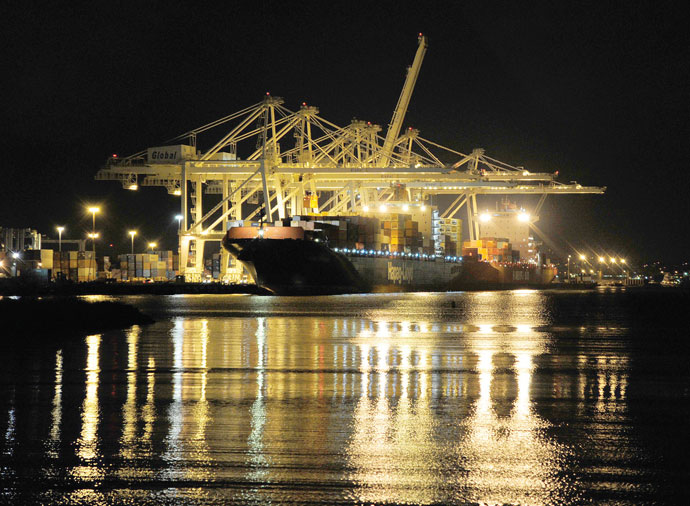Ever since it lent money to help complete the Empire State Building and provided capital to finish Rockefeller Center during the Great Depression, global insurance and benefits company MetLife has been about a lot more than insurance.
Industrial properties accounted for only 6.5 percent of MetLife’s real estate and real estate joint venture investments, according to the company’s latest 10-K. Office properties represented just over 50 percent of the investments.
But MetLife’s latest push is logistics-oriented industrial real estate development with Panattoni Development Co., with major projects in Seattle, California’s Inland Empire, Chicago and Atlanta – and possibly other locations going forward.
MetLife announced July 10 it will develop a new $110-million, large-scale industrial distribution park on 183 acres in Henry County, 15 miles south of the Hartsfield-Jackson International Airport and 25 miles from Atlanta, with California-based Panattoni. The Lambert Farms Distribution Center will offer up to 3 million sq. ft. of distribution space and may accommodate up two facilities. The construction of the park will take about three years and is expected to create about 1,200 full-time construction jobs.
The two companies have plans for an initial portfolio of eight industrial facilities in four states totaling nearly 6 million sq. ft. on 356 acres. In addition to the Lambert Farms project in Atlanta, they plan to build facilities in Seattle, Chicago, the Inland Empire market of California and in the Northeast Atlanta sub-market at Heraeus Industrial Park off I-85.
“MetLife and Panattoni intend to develop in other major industrial markets throughout the United States as economic conditions permit,” said Robert Merck, senior managing director and global head of real estate for MetLife. “Nationally, we think the long-term growth factors for industrial markets in core cities are very positive, and we are excited to have an experienced partner with national reach in Panattoni Development.”
Merck, with MetLife since 1982, is responsible for managing the company’s approximately $60-billion commercial mortgage and equity real estate portfolio (three-quarters of it in commercial mortgages), as well as its $13-billion agricultural investments portfolio. In this capacity, Merck oversees a staff of 265 investment professionals, both domestic and international. A trustee of the Urban Land Institute, he serves on the board of directors of the Real Estate Roundtable.
In an interview, he calls Panattoni is “one of the top players in the country, and they’re very good at developing new properties. We saw this as a good opportunity, given their expertise and our desire to build up our equity portfolio, and specifically to build up our industrial assets.”
Merck says the MetLife team has always liked the industrial space, as in distribution centers and warehouses.
“We’ve found through the years and through our experience in real estate that that is really the better investment versus more specialized R&D space, where you have much more office buildout.” The company is trying to build up its industrial holdings, but Merck says, “It’s difficult because typical industrial property is not that big in terms of dollars. For us, with an almost $60-billion portfolio, it takes a lot to move the needle.”
So how did the needle move toward the first batch of project locations with Panattoni?
“Our focus is on top-quality projects in top-tier markets,” says Merck, with good highway, port and airport access. “And given the changing dynamics in the retail market these days, they have to be close to the major cities.”
Physical Shift from Virtual Lift
“Changing dynamics” is code for e-commerce. According to a report from JLL released in May, 45 percent of Internet customers for brick-and-mortar retailers utilize in-store fulfillment, i.e. using the back room for distribution, thus bringing retail store space and logistics space into overlap, just as they were at the origins of retail itself. Contrary to the usual storyline bemoaning the loss of mom-and-pop, JLL says the trend gives retailers that already have prime real estate in the form of brick-and-mortar stores “a huge competitive advantage against e-tailers that are without a physical presence on our nation’s main shopping streets.”
The entire supply chain figures to be reconfigured, says JLL.

“Depending on specific regional needs and the right IT investment for inventory visibility, a retailer may use a number of industrial and retail facilities,” said the report. “While all brick-and-mortar retailers replenish their store inventories from distribution centers (DCs), some will also invest in, or tap into their e-fulfilment centers (ECs). Other retailers will use existing store inventories to ship directly to shoppers (in addition to their ECs), while some may add a new type of facility such as an urban logistics center or cross-dock.”
MetLife may be known for its airships, but it’s just as interested in the logistics space those airships fly above, such as the burgeoning Northern New Jersey sub-market shown below and opposite. Robert Merck (inset), senior managing director and global head of real estate for MetLife, says industrial markets in core cities across the United States show great promise.
Photos courtesy of MetLife
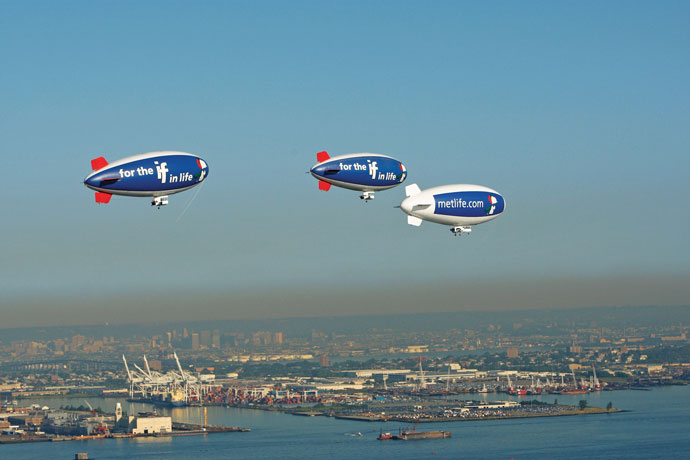
“As more retailers evolve their ship-from-store strategy,” said Kris Bjorson, head of retail/e-commerce distribution at JLL, “we anticipate growing demand for both industrial and retail space in the form of ECs with a broader inventory offering and up to 15 percent of fulfillment space inside traditional retail locations.”
CBRE’s July report on “E-Commerce and the Changing U.S. Industrial Landscape” sounded similar notes in noting a surge in absorption:
“During the first quarter of 2014, virtually all US markets were buoyed by strong demand for distribution space from the e-commerce sector,” said Scott Marshall, executive managing director for industrial services, Americas, CBRE. “Supply chain demand was centered in major inland and coastal port markets, resulting in strong absorption and shrinking availability in markets such as Atlanta, Chicago, Miami and Houston.”
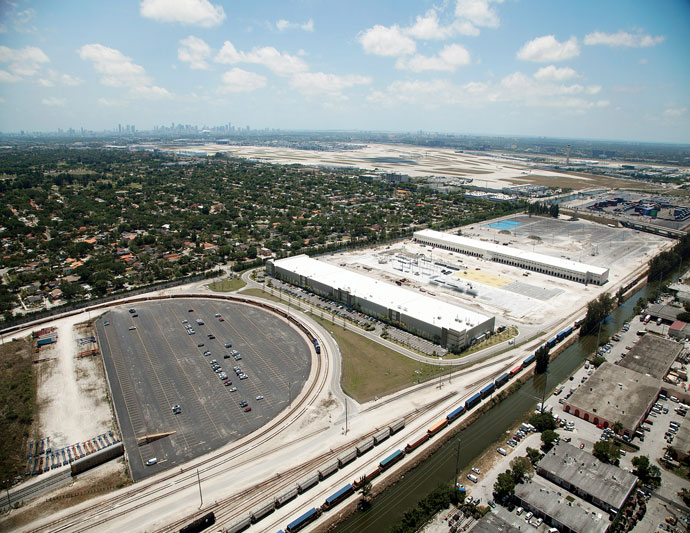
Flagler Station is South Florida’s largest business park with its own turnpike interchange and home to industry leaders such as Ryder, Crowley and FedEx. The entire Flagler Station complex will comprise nearly 14 million sq. ft. of industrial space once the third and final phase is completed.
Photo courtesy of Flagler Global Logistics
The upshot? Approximately 45.7 million sq. ft. of speculative development, says CBRE, in response to active e-commerce requirements totaling 30 million sq. ft. and showing no signs of waning anytime soon. More than 16 million sq. ft. of industrial facilities is under construction in California’s Inland Empire in San Bernardino and Riverside counties, accounting for approximately 14 percent of all industrial space being built in the US. Of the 34 projects currently under construction, many are specifically designed to handle e-commerce order fulfillment.
“By 2017, online sales could account for more than one-tenth of all U.S. retail sales, up from 6.2 percent in 2013,” said Adam Mullen, head of supply chain services, CBRE.
Among the companies rapidly growing its e-commerce distribution and fulfillment operations is department store
Belk Inc., which is investing $28 million at a former Disney facility in Jonesville, S.C., in Union County just south of Spartanburg, with REIT CPA:18-Global chipping in $19 million. Total employment will now come to 314, after another expansion just announced in December 2013 is slated to add 170 jobs. The company reported 42.5-percent growth in e-commerce sales during its fiscal year that ended Feb. 1.
Big or Small, Being Nimble Is What Counts
“As it relates to industrial properties, our focus is on the primary industrial markets – LA/Inland Empire, the Bay Area, Seattle, Dallas, Miami,” says Robert Merck of MetLife’s approach to real estate. “We also like Mexico, and in the industrial space we have a good number of investments there on the debt side.”
In addition to Mexico City and northern Mexico, MetLife’s global industrial portfolio includes multi-story logistics facilities in and around Tokyo, and some industrial lending in the UK.
One of those markets MetLife likes – Dallas-Fort Worth – is seeing more distribution construction than any other market in the US, despite having some of the most logistics space already available. Houston likewise is seeing increased spec activity, goaded in part by the Port of Houston’s No. 1 rank in 2013 for waterborne foreign trade by metric tons, and its reconfiguration of terminals and channels to accommodate the new generation of post-Panamax container ships.
Trammell Crow Co., Clarion Partners and Rosewood Property Co. announced in August their plans for the two-building, 700,000-sq.-ft. Trammell Crow Company JJ Lemmon Distribution Center in the Southern Dallas industrial sub-market. “Class A industrial space in the Southern Dallas market is scarce and demand remains strong due to the efficient network of highways including I-20, I-45 and I-35 as well as the UP Intermodal,” said Scott Krikorian, senior managing director with Trammell Crow’s Dallas-Fort Worth business unit.
Since 1975, Trammell Crow has developed more than 11 million sq. ft. spanning 45 Class A industrial buildings in Southern Dallas with over $400 million in investment.
“The Inland Port at I-20 and I-45 is dedicated to industrial projects just like this one,” said Dallas Mayor Pro Tem Tennell Atkins. “It is in the heart of America. It will create jobs, it will grow the tax base and it will be a magnet for other Class A industrial projects.”
In another of the markets MetLife’s Robert Merck likes – Seattle – Panattoni isn’t waiting around. In June the Port of Seattle Commission approved a lease with Panattoni to develop the 87-acre Des Moines Creek Business Park, where the developer plans to construct up to 2 million sq. ft. of office, flex-industrial, distribution and light manufacturing space near Seattle-Tacoma International Airport. The project is projected to create more than 1,600 new jobs and cost between $100 million and $125 million to build out in phases.
“If you’re located near a major port, and you have a good highway system and good rail system, you’re probably going to be a good logistics market,” MetLife’ Merck says. “Some are smaller, but still good – Memphis is a good market. It’s smaller by comparison, but we’ve had investments in Memphis in industrial, and we like that market.
Recent research from CBRE corroborates Merck’s point about selected – even counter-intuitive – smaller markets. And therein lies an opportunity.
“A large portion of the nation’s industrial real estate is devoted to holding goods as they move through the supply chain,” writes Matthew Ciampa, economist with CBRE Econometric Advisors. Inventories were drawn down during the financial crisis and recession, but have come back strong, he says. “Currently, inventories among wholesalers-the middle segment of the supply chain – are at a record level, nearly 8 percent above the prior peak reached in mid-2008,” he wrote in August.
Even as owners and tenants have streamlined, he writes, “monthly snapshots of aggregated inventories in the intermediate wholesaler segment are showing a long, steady march upward. In this sense, improved efficiency is counteracted by forces such as a growing economy and an increasing population that demands a larger total volume of goods.”
Analysis of Bureau of Labor Statistics employment data by sector can serve as a rough proxy for where new facilities are being built or occupied. Ciampi’s research of wholesale trade employment growth shows that, “since the recovery began, the markets outperforming the sum of markets have been various in type, contradicting the idea that gains have been concentrated only in the largest markets, or those focused on distribution activities.” (See chart.)
Snapshots From Halfway
At least two recent projects have landed in locations known more for being midway than for being mammoth hubs.
Leaders from Katy, Texas-based
Academy Sports + Outdoors recently announced the company will build a new $100-million, 700-job, 1.6-million-sq.-ft. distribution center on more than 200 acres in Cookeville, Tenn., in Putnam County, located halfway between Nashville and Knoxville on I-40. The company is about to build its 10th store in the state, and operates only two other distribution centers in Katy and in Jeffersonville, Ga., southeast of Macon and halfway between Atlanta and Savannah.
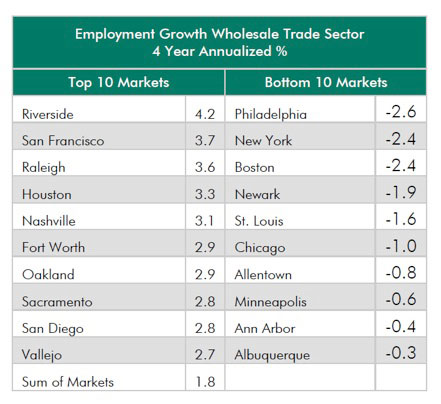
In June,
Tractor Supply Co. selected Casa Grande, Ariz., for its first western distribution center, lured in part by quick action to secure Foreign Trade Zone status for the site. The company, which just broke into the Fortune 500, has added stores at a rate of 100 annually in recent years with a goal of reaching 2,100 stores nationally. The $100-million, 640,000-sq.-ft. facility will employ 250 and deliver merchandise to stores in Arizona, Nevada, Utah, southern California and New Mexico. Casa Grande, which sits roughly halfway between Phoenix and Tucson, also sits in the center of a circle with San Diego, Los Angeles, Las Vegas, Albuquerque and El Paso, all seven to eight hours away by road.
Good Enough for Target and for Amazon
Six of the top 10 for employment growth in the wholesale sector are in California.
Some of the state’s logistics construction and employment activity is taking place north of LA, in Kern County, where Roll Real Estate Development, a division of Roll Global is developing the 1,625-acre Paramount Logistics Park in Shafter. A study by JLL (commissioned by Roll) found the attractiveness of the hub outranked such hubs as Moreno Valley and Stockton, Calif.; Las Vegas and Reno, Nev. and Goodyear, Ariz., when comparing transportation infrastructure, proximity to population centers, workforce availability and growth, wage rates, real estate costs, omni-channel and e-commerce fulfillment, and local and state incentives programs.
“We found Shafter had the most attractive workforce, both qualitatively and quantitatively, of the California competitors,” said Kelly Gray, vice president at JLL, representing the research team at JLL Supply Chain & Logistics Solutions. In addition to major Interstate proximity, the park, home to operations from Target and American Tire, among others, soon will have intermodal rail connecting to the BNSF mainline servicing northern and southern California.
But Reno’s not going anywhere: In March, Dermody Properties broke ground for the first building at its planned 91-acre, three-building LogistiCenter 395 in Reno, Nev., with plans to complete the 624,000-sq.-ft. facility this fall. The facility will feature 36-ft. clear height as well as extra trailer and car parking to accommodate e-commerce companies. At buildout, the park will host 1.2 million sq. ft. of space.
“We are creating
more sophisticated industrial facilities that have the dimensions and capabilities to meet the varied operational requirements of logistics and trade-based businesses.”
– Chris Scott, President and CEO, Flagler Logistics
The plan is working out well so far: In August Amazon.com said it was planning to move from its 15-year-old facility in Fernley, Nev., 30 miles to the east, to the Dermody development. Employees at the Fernley center are being offered the opportunity to transfer. The center employs 600 to 900 year-round, and up to 4,000 during the holiday season.
Ports of Plenty
As MetLife’s Robert Merck indicates, Florida is another place seeing major logistics investment. In May, Flagler Global Logistics – a descendant of the railroad empire of Henry Flagler – broke ground on the $98-million third phase of Flagler Station in Coral Gables, which will add another 1.7 million sq. ft. of new industrial space to South Florida’s largest business park. Flagler closed 233,000 sq. ft. of new industrial leases in the first quarter of 2014.
“The port expansions and restoration of the PortMiami rail line mean a higher volume of goods will move through South Florida and more facilities are needed to accommodate them,” said Chris Scott, president and CEO of Flagler Global Logistics. And right in line with JLL’s analysis, those facilities are being designed with a wide variety of choices, beginning as small as 12,000 sq. ft. “We are creating more sophisticated industrial facilities that have the dimensions and capabilities to meet the varied operational requirements of logistics and trade-based businesses,” said Scott.
The entire Flagler Station complex will comprise nearly 14 million sq. ft. of industrial space once this third and final phase is completed. And at the company’s separate South Florida Logistics Center, a multimodal distribution park adjacent to Miami International Airport, a second and third building are scheduled for completion during the third quarter of 2014. Major leases signed with Flagler during the first quarter came from Krystal Logistics, Medical Technologies Innovators, TVH Parts Co., EMO Trans and Sovereign Container Line. The Center, among other trends, is seeing substantial activity involving Latin American perishables, thanks to its USDA-certified cold chain process.
In addition to owning more than 1.5 million sq. ft. of warehouse space, Flagler, a subsidiary of Florida East Coast Industries, owns 2,000 gross acres of “well-located land” suitable for 24 million sq. ft. of industrial development.
Almost There
After navigating labor strife this year, the $5.25-billion Panama Canal Expansion Program continues apace, receiving in June the second shipment of four rolling gates for the third set of locks – meaning half of the 16 required gates are now on site. The ship took one month to get there from the Port of Trieste, Italy, through the Strait of Gibraltar and across the Atlantic. Gate fabrication, which started in October 2011, is being performed by Italian subcontractor Cimolai SpA. The third shipment of gates is scheduled to arrive in Canal waters in October of this year.
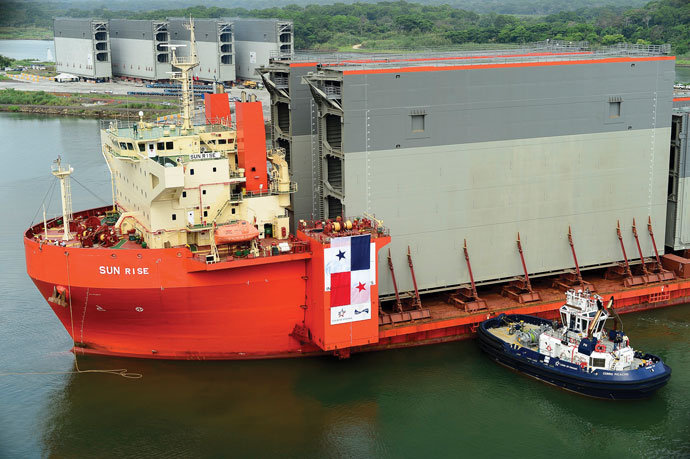
Photo courtesy of Panama Canal Authority
Grupo Unidos por el Canal is the contractor responsible for the design and construction of the Third Set of Locks. Following an agreement signed between the contractor and the Panama Canal Authority, all rolling gates must be in Panama by February 2015.
In August, as the Canal celebrated its 100th anniversary, Panama Canal Administrator Jorge L. Quijano received a Maersk Line delegation led by Søren Skou, CEO of Maersk Liner Business. The ties between the two date to when the first A.P. Møller vessels transited the waterway in 1917 and later established in 1934 a regular route between Baltimore and Asia through the Canal. Analysis from SNL Real Estate says the ports of Baltimore and Hampton Roads, Va., are the only ports on the East Coast ready to accommodate the new post-Panamax vessels, while the ports in Miami, Savannah, Ga., and Charleston, S.C., are dredging; and the Port of New York and New Jersey is raising the Bayonne Bridge.
Of the metropolitan statistical areas with exposure to key ports, said SNL, “publicly traded industrial and diversified REITs have the highest exposure to the Houston MSA, with a total of 21.8 million sq. ft. spread among 208 properties. The Baltimore and Hampton Roads, Va., MSAs have industrial properties owned by industrial and diversified REITs totaling 10.5 million sq. ft. and 1.2 million sq. ft., respectively.”
Other South Florida projects responding to surging demand include the August purchase of acreage in Davie, in Broward County, for development of Bridge Point Davie by Chicago-based Bridge Development Partners. The planned 145,800-sq.-ft. industrial facility with 32-ft. ceilings will be positioned with excellent access to Interstates 595 and 95, Florida’s Turnpike, the expanding Fort Lauderdale-Hollywood International Airport, and the Port Everglades, which is also expanding.
“This is our fourth major project in South Florida,” all in less than a year, said Bridge Principal Kevin Carroll.
Bridge is also upgrading and expanding at a 55-acre logistics park once operated by the former Chicago-area Dominick’s grocery chain at another US hub – Chicago.
Renamed Bridge Point Northlake, the site is close to O’Hare International Airport with immediate access to Interstates 294 and 290 and is less than 10 miles from Interstates 90, 88 and 355. The site also is bordered on the east by Union Pacific Railroad’s west coast trunk line.
